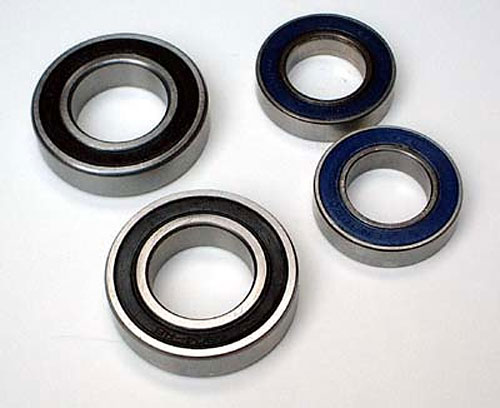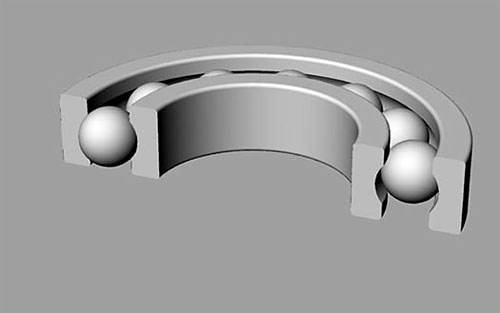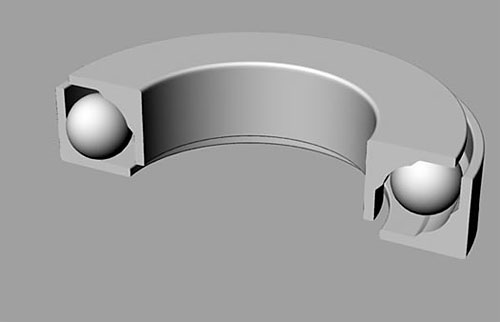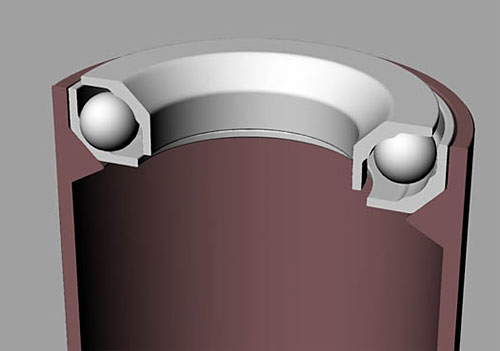What the hell is a Hidden Headset?
*This article first appeared in Ride UK (#73) and is reproduced here by kind permission of Ride UK.
What the hell is a Hidden Headset?
Good question. And surprisingly hard to answer.
Fifteen years go when I became a born-again BMXer, headsets were utter utter shite. You had two choices, a Tioga Beartrap in a size that fitted, or a Tioga beartrap in a size that didn’t fit. These were all one inch threaded headsets but for some reason there were several sizes to choose from, getting the right one was always a pain. Once you had your headset fitted you then spent most of your time tightening it. After every ride it was loose, shit, it was probably loose five minutes after you started riding. This was only 1988 but headsets were working on technology from 1888, or rather NOT working on technology from 1888.
Then came the Aheadset, no threads, YAY! One size, YAY! Stronger forks, YAY! Stems that didn’t slip all the time, YAY! At last we had a standard to embrace, OK so it still used a rough-arse unsealed bearing and it was still a bit weak and flimsy, but it was undoubtedly forward progression. Over the last ten years we have grown complacent and forgotten all about the nightmare that was small threaded headsets; cups have got stronger and most people can go months without touching their headset.
But now things are changing again, lots of frames are boasting a HIDDEN headset and loudly proclaiming it to be a huge leap forward. Hooray! But hang on a minute… What is so aesthetically displeasing about the aheadset that we now need to “hide” it? Is this a real step forward or change for change’s sake?
Balls
We are all familiar with the terms “ball bearing”; “sealed bearing”; “un-sealed bearing” etc but they are often misused so lets clear up the definition first.
Sealed bearing; This is what most of us think of when we hear the words “sealed bearing.”

A fantastically well made rolling element cartridge bearing, precision ground to a very high tolerance so that it needs no adjustment and just spins beautifully. Two little rubber shields keep some of the crap out and they fit into a housing that is usually a slightly tight fit. They aren’t actually “sealed” but they are at least bearings.
Sadly most headsets don’t use these. Instead we have an array of balls loosely tied together by a soft metal “cage” to make a ball necklace that we drop into a cheap steel cup. A “cone” then sits on top and we adjust the assembly to take the slack out.
So why don’t we use “sealed bearings” in headsets? Well the type shown above just wouldn’t be up to it, although they are big and beefy they are designed to take mainly “radial loads”, ie. loads at right angles to the axis of rotation. Like wheel or pedal bearings. They can take some small axial loads more than enough for a wheel say which only gets an axial load when you bang the wheel sideways into the ground, for example fluffing a tailwhip. If you cut one in half it would look like this:

As you can see the contact points are at the inside and outside of each ball so this is the direction it can best carry loads.
But there are other cartridge bearings which ARE designed to take big axial loads. These are called “Thrust” bearings. A pure thrust bearing can take huge axial loads so it’s the sort of bearing you put at the end of a ships propeller shaft to take the thrust from the propeller and use it to push the ship forwards.
BUT a pure thrust bearing can take almost NO radial load. Cut in half one would look like this:
As you can see this sort of bearing can just fall to bits and needs to be loaded to hold it together, and the contact points are top and bottom.
So for a headset what can we use? Forks take a lot of force straight along their length but they also take sideways and head on impacts that cause big radial forces too…
Well there is another type of cartridge bearing called an “Angular contact bearing”, these look more like this:

With angled contact surfaces they cant take radial loads as big as a pure radial bearing or thrusts as big as a dedicated thrust bearing BUT they can take pretty big loads in BOTH directions unlike either of the others.
This is the basic bearing arrangement used in nearly ALL headsets. In our current cheap Aheadsets the outer race is built into the cup and the inner is the cone. But you can also buy fancy ones where a cartridge unit, that looks a lot like the one above, is employed and sits inside a separate cup and cone which act simply as seats.
So since these newer headsets have a separate bearing-race and cup, somebody realised that the cup was now only acting as an adapter to let the headtube hold the bearing unit. And that if the headtube was made bigger and had the precise bearing seat built in the cup would no longer be necessary.
This would result in two less components which is obviously simpler and lighter, it also means that the headtube can be a little longer to reach the normal position where the bearing would sit in its cup. This means that the toptube and down tube are welded a little further from the end which can help reduce distortion.
If this was the whole story then there wouldn’t be anything to worry about, but there is more. It is an unfortunate fact that when you weld things they tend to distort. SO when a headtube is welded on it tends to become slightly oval. The traditional solutions to this are either doing nothing and hoping the tight fit of the cup sorts it out; OR to ream and face the headtube. Reaming and facing is fine for high end frames but it needs to be carefully allowed for, plus it adds cost. Reaming and facing an actual bearing seat is much more difficult so the manufacturers of Hidden headsets have tried to design the problem out.
This is a representation of what a hidden headset would look like sawn in half.

As you can see there is a very slight gap between the bearing unit and the headtube sides. This means that you will never have to hammer your bearings in or out; Woo-Hoo!
Instead the bearing unit sits on a forty five degree chamfer. As the top bolt is tightened the bearing unit settles down into this conical seat which matches a conical chamfer on the outside of the bearing.
This ridge on the inside of the headtube isn’t the easiest thing to make, hence the increased cost of a frame with a Hiddenset BUT it does add considerably to the rigidity of the headtube, Flareing resistance is increased and the headtube is less likely to deform during welding.
The downside is hard to explain but I will give it a go.
The first biggie is that the frame needs to be well made. As long as the hiddenset is mainly on the top end bikes it will probably work very well, but on cheaper bikes with a higher tendancy to distort under welding, things could start going wrong. IF the headtube does distort from round to a slight oval then the bearing will not sit on its forty five degree ledge properly. It may touch only at the sides while the front and back sit a little away from the seat. This would manifest itself as a very slight wobble under big loads. Every time you hit a ramp it might click or groan. As time went by this movement would reduce the bearing unit life drastically. And if it was run with broken bearings all the usual problems of flared headtubes would be likely, only mending a hiddenset headtube is likely to be even harder then an ordinary frame.
Another consideration is also related to wobble. If the headset is even slightly loose then the bearings can wobble around in their seats; in the same way a funnel can rattle about in the neck of a bottle. If this isnt corrected then it can wear the seats or even flare the headtube. Lastly we should consider that the Hiddenset wasn’t developed for BMX, it wasn’t even designed for mountainbikers. This is road-bike technology! Those skinny but fit guys who hammer round the Tour de France are undoubtedly hard on bikes in their own way but it is very different to us scum-bags launching off ramps, steps and dirt jumps into oblivion.
Campagnolo who make the Hiddenset used to make BMX racing parts many many years ago but they dumped us when things got tough in the Eighties. If the hiddenset isn’t a success with road racers they wont keep it alive for us BMX peasants…. So, if you are thinking of going for a frame with a hiddenset bear this in mind, if it doesn’t work out there is no way to go back to a normal headset.



